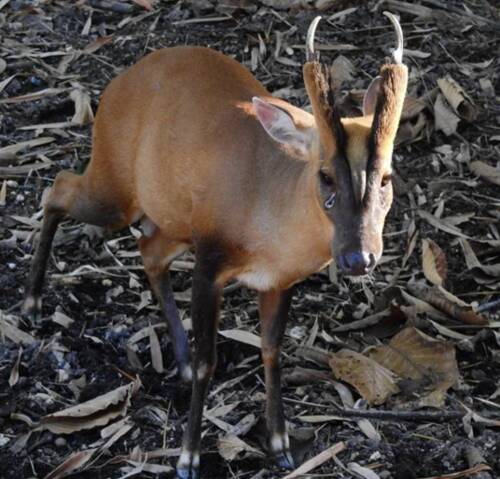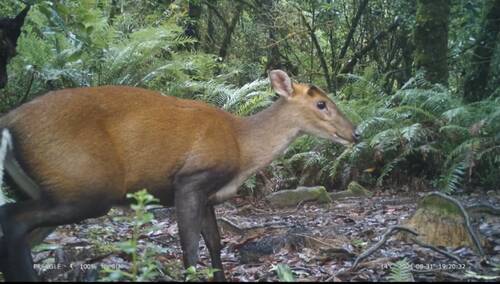Muntiacus feae
IUCN
LCBasic Information
Scientific classification
- name:Muntiacus feae
- Scientific Name:Muntiacus feae,Fea's Muntjac、Forest muntjac,Wood muntjac, black muntjac, Fischer's muntjac
- Outline:Ungulata
- Family:Artiodactyls Cervidae Muntjac
Vital signs
- length:About 104 cm
- Weight:About 20kg
- lifetime:About 12 years
Feature
The shape of the nasal bone is long in the middle and short on both sides, forming an inverted "V" shape.
Distribution and Habitat
Existence: distributed in Myanmar, Thailand, China.
Uncertain existence: Laos, Vietnam.
In Tibet, the Philippine muntjac mainly inhabits coniferous and broadleaved mixed forests or shrubs at an altitude of 1500-3000 meters, near streams and with high relative humidity. The dominant species of conifers are mainly Huangshan pine, southern hemlock, fir, masson pine, cryptomeria, and Torreya grandis. The vegetation is mainly coniferous and broadleaved mixed forest belts, with conifers as the main species, including Armand pine, Larix principis-rupprechtii, Quercus liaotungensis, and birch; shrubs and herbaceous plants mainly include Axolotl, Cottonwood, and ferns. The dominant species are mainly wild green grass, marsh grass, Miscanthus, and wild ancient grass of the Poaceae family. The habitat conditions are extremely special, with low temperature, high humidity, strong wind, abundant rainfall, long foggy days, and mountain meadow soil. Distributed in the middle mountainous area abo
Appearance
The Philippine muntjac weighs about 20 kg, is about 104 cm long, has a shoulder height of about 68 cm, a hip height of about 70 cm, a tail length of about 15 cm, an ear length of about 11 cm, and a hind foot length of about 30 cm. The body size is comparable to that of the black muntjac or the red muntjac, but the posterior edge of the premaxilla touches the front 1/3 of the nasal bone. The frontal gland and infraorbital gland are obvious. The frontal gland is a characteristic of the genus Muntjac. The frontal gland of Philippine muntjac is about 5 cm long. The shape of the nasal bone is long in the middle and short on both sides, forming an inverted "V" shape. The main part of the horn is very short, only slightly longer than the eyebrow fork, almost like a crab claw. The hair on the forehead, ear base, and behind the eyes to the outside of the horn base of Philippine muntjac is bright brown. There is a black stripe about 2 cm wide on the inner front side of the handle on bo
Details
Fea's Muntjac (scientific name: Muntiacus feae) is also known as Fea's Muntjac and Forest muntjac in foreign languages. It has no subspecies.

Philippine muntjacs often move alone, and when startled, they often swim across streams and hide in the forest on the other side. When frightened by predators, Philippine muntjacs will bark, perhaps to alert their peers to danger or to let predators know that they have been discovered. Omnivores feed mostly on shade-tolerant herbs and young leaves of shrubs, and prefer mosses and ferns. They feed on herbs and leaves, bark, mushrooms, fruits, and may even feed on bird eggs, bird chicks, and small mammals. Individuals of the Fischbacher's muntjac tend to grow in densely wooded areas and prefer more digestible vegetation rather than grass. Their rumen has two blind sacs, and food passes through the digestive system relatively quickly compared to herbivorous even-toed ungulates. Foraging mainly occurs at night; small mammals and birds are preyed on with hooves and fangs.
Each litter of the Fischbacher's muntjac is one (Sheng Helin, 1998). Males may fight for access to females through horn fighting or using fangs, although little is known about female mating. Males are likely to defend a territory containing several females. Like other subtropical muntjacs, the Philippine muntjac may breed year-round, but breeding may be concentrated in winter. The antlers are thinner than those of other members of the subfamily Muntiacinae, suggesting that intraspecific combat between males and antlers may not play as much of a role in mate competition as in other muntjacs. Young muntjacs stay with their mothers until they mature. Philippine muntjacs, like other muntjacs, have a relatively short lifespan compared to other deer. There is little data on the lifespan of Philippine muntjacs, but one wild Philippine muntjac survived nearly 12 years in captivity.
The distribution range and abundance of Philippine muntjacs in the Gaoligong Mountains of China are unknown, but their numbers are undoubtedly rare (Sheng Helin, 1998). Surveys from 2001 to 2006 showed that poaching still occurs in the Philippine muntjac distribution area in Tibet and Yunnan, China, and that the distribution is narrow, the habitat is severely damaged, and the population is rare.
Staff from the Tibet Autonomous Region Forestry Survey and Planning Institute found a clear image of the Philippine muntjac while sorting out the data from infrared cameras deployed in Medog County.

Philippine muntjacs live in habitats with dense vegetation and high humidity. This type of habitat may be a limiting factor for their distribution. Deforestation and environmental changes are not conducive to the survival of this species of animal. However, in Tibet, China, local residents do not specifically hunt Philippine muntjacs, and the population is sparse, so human hunting activities are not a threat factor. The cause of the endangerment needs further investigation (Sheng Helin, 1998).
Philippine muntjac has 1,200 hectares of Gaoligong Mountain Nature Reserve in Yunnan Province, China, and Bomigang Township Nature Reserve in Tibet. It is estimated that Philippine muntjacs are also active in Zayu Nature Reserve and Medog Nature Reserve in Tibet. Philippine muntjac populations in existing reserves should be well protected. Philippine muntjac populations are distributed in a small range in China and are rare in number. It is recommended to conduct a comprehensive investigation and study on its population size, distribution, biological characteristics and endangerment causes, and it is recommended to list it as a national first-class protected animal.
Listed in the "Red List of Threatened Species of the World Conservation Union" (IUCN) 2015 ver 3.1-Data Deficient (DD).
Listed in the "Red List of Biodiversity in China" (Mammals)-Endangered (EN).
Protect wild animals and eliminate game.
Maintaining ecological balance is everyone's responsibility!








